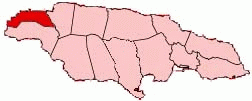
Population : 67,000
Capital : Lucea
Major Towns: Green Island, Sandy Bay,Hopewell

Hanover, the third smallest parish in Jamaica, is located at the northwestern end of the island, covering an area of 450.4 square kilometers (173.9 square miles). The parish is home to six rivers, two of which flow into the horseshoe-shaped Lucea Harbour, one of the safest harbors on the island. Surrounded by hills on three sides, the picturesque Dolphin Mountain range, with its highest point at Dolphin Head (1,789 feet), forms a scenic backdrop. The highest elevation in the parish is Birchs Hill, standing at 1,809 feet. Fort Charlotte, located on the western edge of the harbor, could historically accommodate 300 ships at once, as noted by the 18th-century historian Edward Long. Hanover also features three small waterfalls, several coastal coves, and large caves, making it a region ripe for
exploration. After heavy rainfall, a temporary lake often forms in Chigwell in the parish's interior.The first recorded mention of the area now known as Hanover dates back to 1515 when King Ferdinand of Spain praised the Spanish Governor for relocating Spaniards there after the abandonment of Sevilla la Nueva. Hanover Parish was officially established on November 12, 1723, and named after the English royal family from the House of Hanover. The coastal coves were once popular pirate haunts, including Henry Morgan, who later became Lieutenant Governor and acquired 4,000 acres in the area.
In its early colonial days, Lucea, the main town, was busier than Montego Bay. By the mid-18th century, Lucea thrived as a sugar port and market center. European Jews settled here, contributing as merchants, shopkeepers, clothiers, shoemakers, and goldsmiths, and the town became a free port. Post-emancipation, free peasants flourished, supplying produce to much of Jamaica. Several structures from this era remain, showcasing 'Caribbean vernacular' architecture. The Hanover Parish Church, originally built by the Spaniards and the only one on the island with a steeple, lost its steeple due to damage from the 1957 earthquake.
Lucea is believed to have welcomed the first ship carrying Scottish Presbyterian missionaries, explaining the strong presence of Presbyterians (now the United Church of Jamaica and Grand Cayman) in the parish. The Lucea yam, a popular local crop, was exported in large quantities in the 19th century to Jamaican laborers in Cuba and Panama. The harbor, once used for exporting bananas, was closed in 1983, although the old Fort Charlotte still stands at the harbor entrance.
Bloody Bay in Negril, reputedly named for whale killings, was a historic meeting point for ships bound for Europe and naval defense vessels.
Notable residents of Hanover include Walter Jekyll, a scholar and author of "Jamaica Song and Story," and National Hero Sir Alexander Bustamante, born in Blenheim.
In recent times, Lucea has revitalized with the return of many migrants, blending modern developments with its 19th-century charm. Tourism has become a key industry, although infrastructure improvements are still needed.
Agriculture:
Key crops include yams, sugar cane, pimento, turmeric, and breadfruit.
Livestock Rearing:
Prominent in areas such as Shettlewood, Knockalva, Ramble, Haddo, Saddlers Hall, Burnt Ground, and Haughton Court, focusing on cattle, pigs, and goats.
Tourism:
Notable resorts include Round Hill, Tryall (known for its golf course), and various hotels along the Negril strip, such as Grand Lido, Couples, Sandals, Negril Cabins, and Beaches.
Hanover's rich history, scenic beauty, and evolving economy make it a fascinating and vibrant part of Jamaica.